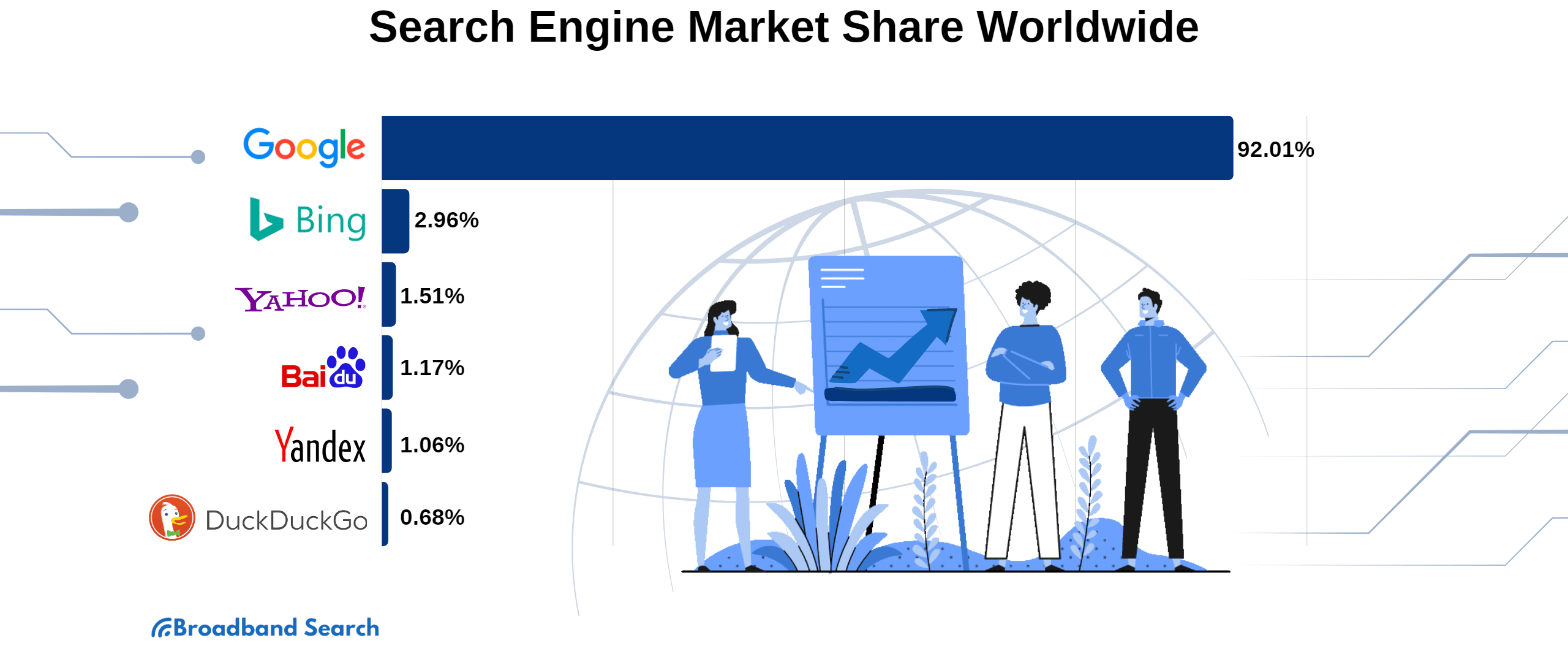Google, with its vast array of services and ubiquitous presence, has become an integral part of our daily lives in today's digital world. Its prevalence extends to mobile usage with a significant share of Android activations and the global browser market. Google-owned platforms like YouTube and Gmail boast massive user bases. Additionally, Google's advancements in cloud services, commitment to sustainability, and influence on communication are remarkable. Understanding these statistics underscores the immense importance of Google in our interconnected digital lives.
Google's Connection to Alphabet
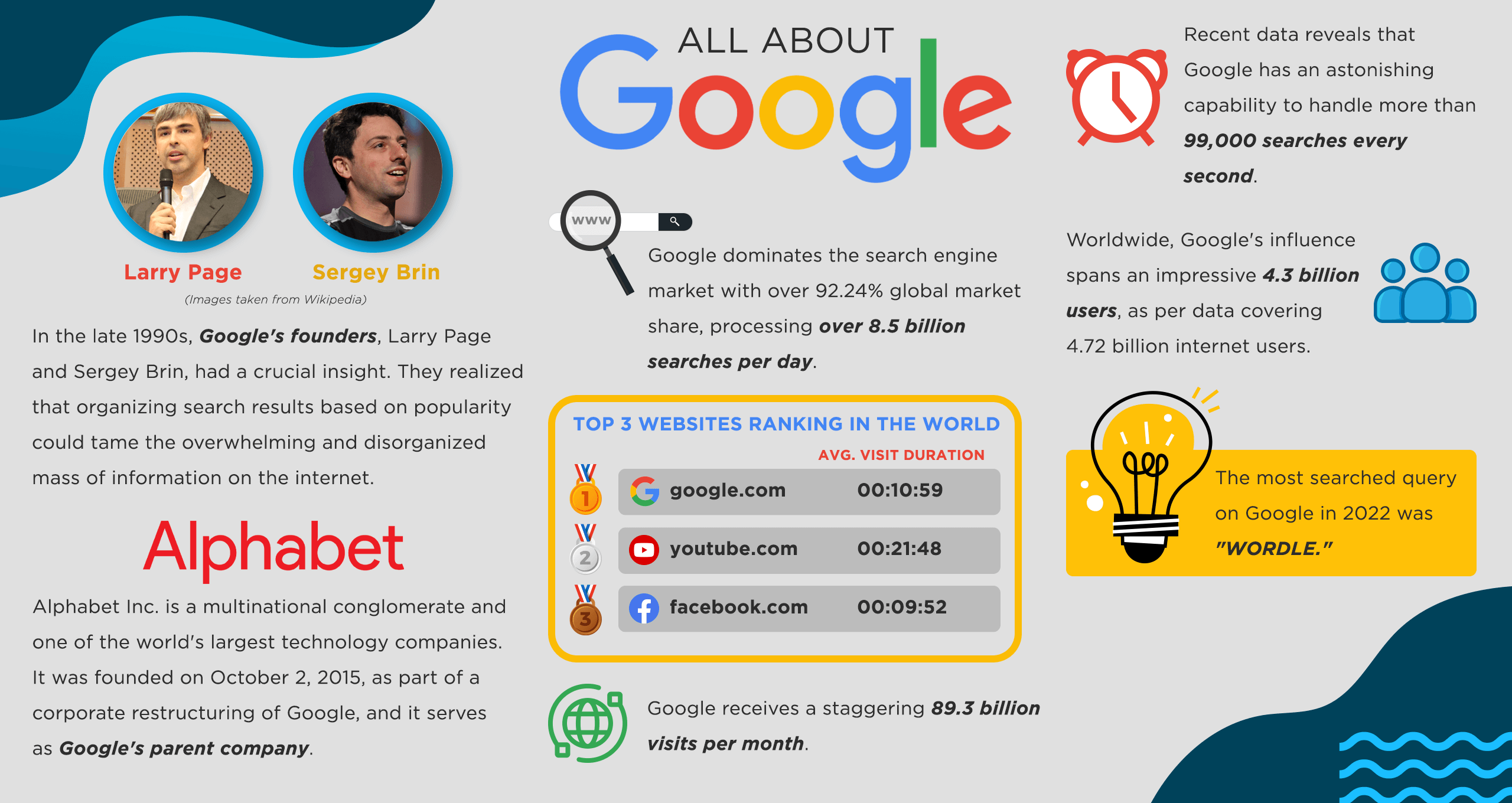
On August 10, 2015, Google made a significant announcement that it would undergo a transformative restructuring, creating a new public holding company called Alphabet Inc. This strategic move was introduced by Larry Page, Google's co-founder and CEO, through a blog post on the official Google blog.
The primary objective behind the creation of Alphabet was to streamline Google's operations by shifting certain subsidiaries from Google to Alphabet. This restructuring aimed to narrow the focus of Google, allowing it to concentrate on its core internet-related products and services.
By forming Alphabet as a parent company, Google gained a more diversified corporate structure. It facilitated greater clarity, transparency, and accountability in managing the various ventures under the Alphabet umbrella. This new framework provided autonomy and independence to Alphabet's subsidiaries while allowing Google to maintain its prominent position within the organization.
While Google remains the most prominent subsidiary of Alphabet, responsible for popular platforms such as Google Search, Google Maps, YouTube, Google Ads, and Google Cloud, the restructuring created opportunities for other ventures to thrive independently.
1. Search Engine Dominance
Global Market Share in Search
Google dominates the global search engine market, handling over 90% of all search queries worldwide.
Comparison of market shares:
- As of May 2023, Google's market share for search queries is a whopping 93.12%, with more than nine out of ten internet users choosing Google for online information searches.
- Microsoft's Bing, the closest rival, holds a mere 2.77% market share.
- Yandex, the popular search engine in Russia, ranks third with a market share of 1.15%.
- Yahoo follows closely with a market share of 1.11%.
- DuckDuckGo occupies the fifth position, holding 0.51% of the market share.
- Baidu, the leading search engine in China, wraps up the top six with a market share of 0.49%.
- Collectively, Bing, Yahoo, Yandex, DuckDuckGo, and Baidu's market shares add up to only 6.03%, a fraction of Google's dominance.
Historical Trend of Google's Market Share Growth
Google's market share has witnessed consistent growth over the years, firmly establishing its position as the industry leader. The founders of Google, Larry Page and Sergey Brin, had a pivotal realization in the late 1990s. They understood that the overwhelming and disorganized mass of information on the internet could be tamed by ranking search results according to their popularity. This insight became the foundation of Google's success.
With the integration of search and advertising, Google embarked on a path of relentless innovation. Recognizing the potential for increased revenue and ad space as traffic and content grew, Google strategically published and acquired digital assets. These strategic moves included noteworthy acquisitions such as YouTube in 2006, Google Maps in 2005, Google Blogger in 2003, and Google Finance in 2006.
By capitalizing on these acquisitions and leveraging their offerings, Google solidified its market dominance. It seamlessly integrated popular platforms like YouTube, expanded its services with Google Maps, facilitated content creation through Google Blogger, and provided financial information through Google Finance. These calculated steps allowed Google to continually drive growth, cementing its position as the leading force in the search engine market.
Impact of Google's Dominance
Google's unparalleled presence in the digital landscape has far-reaching implications that shape the competitive landscape and user behaviors. This influence extends beyond its commanding position in the search market to encompass other vital aspects of the advertising industry.
Notably, Google's dominance extends to text ads displayed alongside search results, accounting for an astonishing 70% of global search advertising revenue.
Additionally, Google leads the way in display advertising by directly placing banner ads on third-party publishers' platforms, securing three-quarters of the direct channel—an invaluable ad inventory that major web publishers directly negotiate with advertisers.
Strategies to Maintain Market Share
Google employs various strategies to retain and attract users:
- Market Penetration (Primary): Google focuses on market penetration as its primary growth strategy, particularly outside the United States. The aim is to expand its customer base within existing markets.
- Product Development (Secondary): Google emphasizes product development as a secondary strategy to drive growth through innovation and the introduction of new offerings.
- Market Development (Supporting): Google utilizes market development as a supporting growth strategy by targeting new market segments and exploring novel uses for its existing products.
- Diversification (Supporting): Diversification serves as a supporting strategy for Google's intensive growth, enabling the company to expand into new markets or industries where it currently has limited presence.
Daily Searches Conducted on Google
Google's unrivaled dominance in web search is highlighted by its astounding search volume. Recent data showcases Google's incredible capacity, processing over 99,000 searches per second. This staggering figure accumulates to more than 8.5 billion searches conducted on Google each day.
Google's Dominance in Search
Google's popularity and the trust users place in it are evident in the billions of searches it processes.
- As the most visited website, Google receives a staggering 89.3 billion visits per month.
- Mobile search is on the rise, and Google is at the forefront of this trend. Mobile devices take precedence even on Google, with 63% of Google's organic search traffic in the US originating from mobile devices.
- Since the last quarter of 2013, mobile searches on Google in the United States have experienced a consistent increase.
User Behavior and Search Patterns on Google
Google's user behavior and search patterns are driven by several factors that make it the preferred search engine for many. Users gravitate towards Google due to its exceptional accuracy, relevance, and user-friendly interface, resulting in increased search activity.
In a 2014 study, Google ranked first among participants in terms of interface design preference, showcasing its appeal. The findings revealed that every participant was familiar with Google, with a significant portion relying on it daily. When compared to competitors like Yahoo! and Bing, Google stood out for its simplicity and ease of use, solidifying its position as the go-to search engine for users seeking a streamlined search experience.
2. User Base and Reach
Active Google Users worldwide
In the United States, Google boasts an impressive 246 million regular users, highlighting its popularity and widespread usage in the country. Globally, Google's reach extends to a remarkable 4.3 billion users, based on data encompassing 4.72 billion internet users. The month of April 2021 alone witnessed 3.5 billion new visitors accessing Google's services in the United States.
Across Different Google Services
Search
Google dominates the search engine market with over 92.24% global market share, processing over 8.5 billion searches per day.
Gmail
Gmail has experienced remarkable user growth over the years. Starting with 900 million users in May 2015, the number quickly rose to 1 billion by February 2016. By October 2018, Gmail's user base expanded to 1.5 billion, and it currently stands at an impressive 1.8 billion users. This achievement has solidified Gmail's position as the email service with the highest number of users worldwide. Globally, there are currently 4.3 billion email users, representing approximately 85% of internet users. Projections suggest that this number will increase to 4.6 billion by 2025, indicating continued growth in email usage..
YouTube
YouTube boasts an impressive user base of over 2.5 billion monthly users, making it one of the most widely used video-sharing platforms. On a daily basis, users collectively watch an astonishing one billion hours of videos. Notably, the rate of video uploads on YouTube is equally remarkable, surpassing 500 hours of content uploaded per minute as of May 2019.
Factors contributing to Google's popularity among global users
- Reliable search results: Google's accuracy and relevance in delivering search results.
- Diverse services: The wide range of services offered by Google, including search, Gmail, YouTube, Google Maps, and more.
- User-friendly interface: Google's intuitive and user-friendly design across its platforms.
Percentage of Internet Users who use Google
Google's Dominance in the Search Engine Market
- Google is the go-to search engine for the majority of internet users, securing a significant market share.
- Dominating the search engine market, Google consistently maintains an average market share of 86-96% worldwide.
- As of June 2022, Google's global search engine market share stood at an impressive 91.88%, reaffirming its unparalleled dominance in the search engine industry.
Demographic Breakdown of Google Users
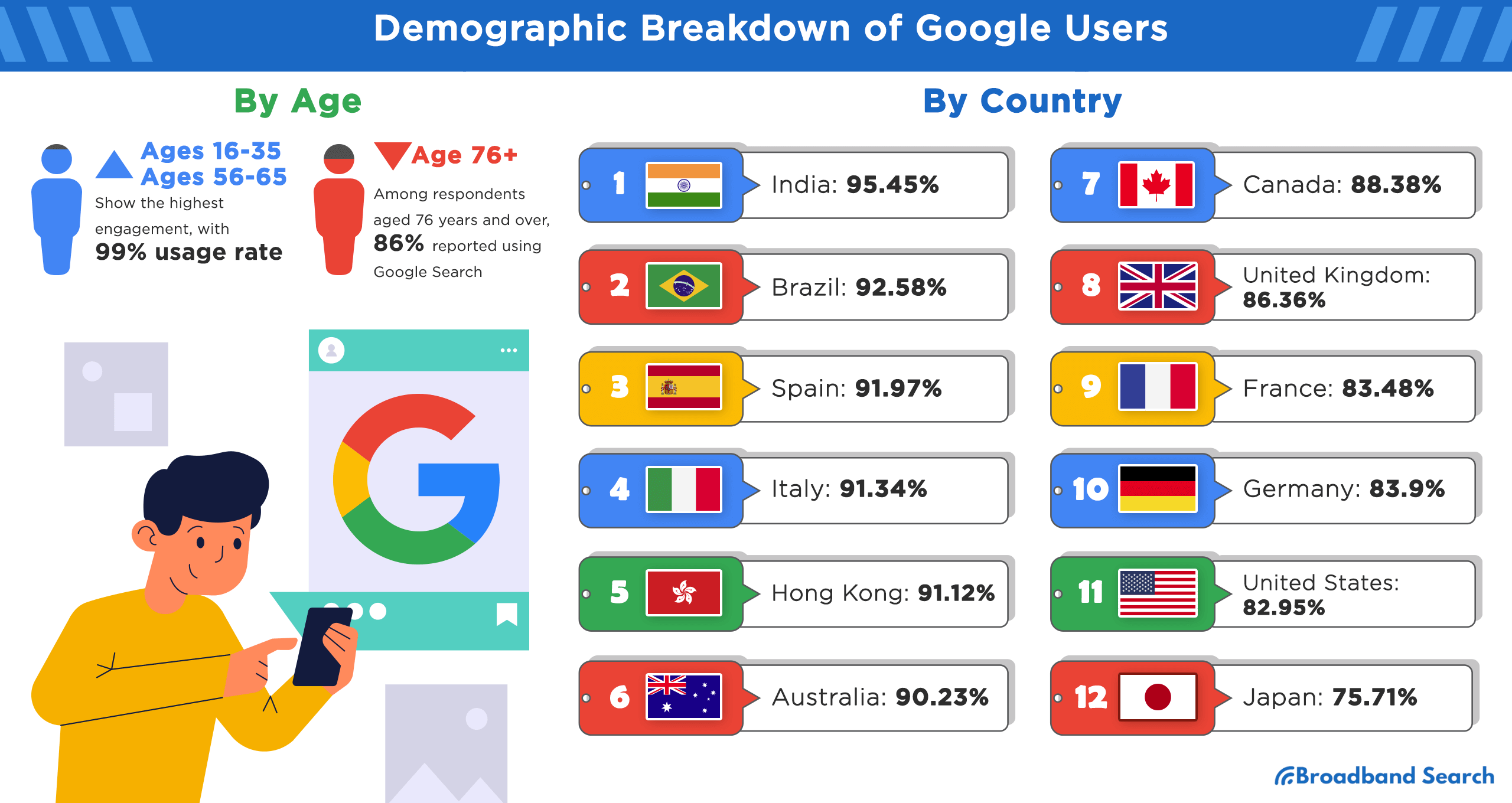
Age
When it comes to Google Search usage, two distinct age groups stand out as the most active users. Individuals aged between 16 and 35 years, as well as those aged between 56 and 65 years, show the highest engagement, with a remarkable 99 percent usage rate. In contrast, among respondents aged 76 years and over, 86 percent reported using Google Search.
Location
Google's influence spans across the globe, with a strong presence in 219 countries and territories worldwide. This vast coverage demonstrates the extensive reach and penetration of Google's services on a global scale.
Top Countries by Google Users and Percentages
- India: 95.45%
- Brazil: 92.58%
- Spain: 91.97%
- Italy: 91.34%
- Hong Kong: 91.12%
- Australia: 90.23%
- Canada: 88.38%
- United Kingdom: 86.36%
- France: 83.48%
- Germany: 83.9%
- United States: 82.95%
- Japan: 75.71%
The Impact of Google's User Base on Advertising and Digital Marketing Strategies
- Advertising reach: With billions of users, Google offers immense potential for reaching a vast audience.
- Targeting capabilities: Google's user data and advanced targeting options enable advertisers to tailor their campaigns effectively.
- Search engine optimization (SEO): Businesses strive to optimize their visibility in Google search results due to its market dominance.
3. Revenue and Profitability
Annual Revenue Generated by Google
During the first quarter of 2023, Google achieved a remarkable revenue of over 69.4 billion U.S. dollars, showcasing an increase from the 67.2 billion U.S. dollars recorded in the corresponding quarter of the previous year. Furthermore, Google's annual revenue for 2022 reached an impressive milestone, totaling 279.8 billion U.S. dollars, marking its highest revenue value to date.
Breakdown of Revenue Sources
- Search Ads: In 2022, Google's revenue sources were analyzed, revealing that search ads played a pivotal role in driving its financial success. Of the impressive $279.81 billion in total revenue generated by the company, a significant portion of $162.45 billion was derived from search ads.
- Google Network Ads: Apart from search ads, Google Network ads emerge as the second-largest revenue source for Google. In 2022, these ads generated a substantial $32.78 billion, accounting for 11.7% of the total revenue. This category encompasses advertisements displayed on Google's partner sites, showcasing the reach and effectiveness of Google's advertising network beyond its own platforms.
- Youtube Ads: Next in line is YouTube ads, serving as Google's third-largest income source. Generating a notable $29.24 billion in revenue, YouTube ads accounted for 10.5% of Google's total revenue.
- Apps, Hardware, and Content: Generating $29.06 billion in revenue, this category secures the fourth spot on Google's list of top revenue sources, contributing to 10.4% of the total revenue.
- Google Cloud: With a revenue of $26.28 billion, Google Cloud stands as the fifth-largest income source for the company, accounting for approximately 9.4% of its total revenue in 2022.
Factors Contributing to Google's Revenue Growth
Advertising remained the primary revenue-generating segment for Google in 2022, contributing to 80.2% of its total revenue. The company's strong advertising platforms, including Google Ads, played a significant role in driving revenue growth. To diversify revenue streams, Google expanded into cloud services, hardware sales, and other ventures. Leveraging its extensive user base across services like search and YouTube, Google maximized its advertising potential.
The company generated revenue through advertising sales and various service fees, utilizing its search engine, web browsing platforms, mobile operating systems, and cloud computing. In terms of growth, Google Cloud, the cloud computing segment, experienced rapid revenue growth, accounting for 9.3% of total revenue in 2022, up from 4.3% in 2018. Google operates under three reportable segments: Google Services (the most profitable), Google Cloud, and Other Bets, with Google Cloud and Other Bets occasionally reporting operating losses.
Market Capitalization
As of July, Google boasts an impressive market capitalization of $1.514 trillion. This positions Google as the fourth most valuable company globally based on market capitalization, according to available data.
Factors influencing Google's market valuation
- Financial performance: Google's strong revenue growth, profitability, and positive earnings outlook impact its market valuation.
- Market trends and investor sentiment: Market perception of Google's future prospects and industry trends affect its market capitalization.
Profit Margins and Financial Success
Google's Profit Margins and Profitability Ratios
Google, under Alphabet Inc., consistently maintains healthy profit margins, showcasing its financial strength and stability.
Gross Profit Margin: As of March 31, 2023, the company's Gross Profit Margin stood at an impressive 56.14%. This metric reveals that Alphabet retains 56.14% of its total revenue after deducting the cost of goods sold.
Operating Margin: According to the latest financial reports and stock prices, Google's operating margin stands at an impressive 24.92% at present, indicating the company's ability to generate profits from its operations. Furthermore, as of the end of 2022, Google boasted an operating margin of 25.22%, highlighting its consistent performance in maximizing profitability. These figures demonstrate Google's effective cost management and revenue generation strategies.
Net Profit Margin: In terms of net profit margin, as of March 31, 2023, Alphabet Inc. (Google) achieves a remarkable net profit margin of 20.58%. This figure signifies the percentage of revenue that translates into net profit after accounting for operating expenses, taxes, and other costs.
Key Drivers of Google's Financial Success
- Cost management: Effective cost controls and operational efficiencies contribute to maintaining healthy profit margins.
- Revenue diversification: Google's expansion into multiple revenue streams reduces reliance on a single product or service, enhancing financial resilience.
4. Cloud Services and Infrastructure
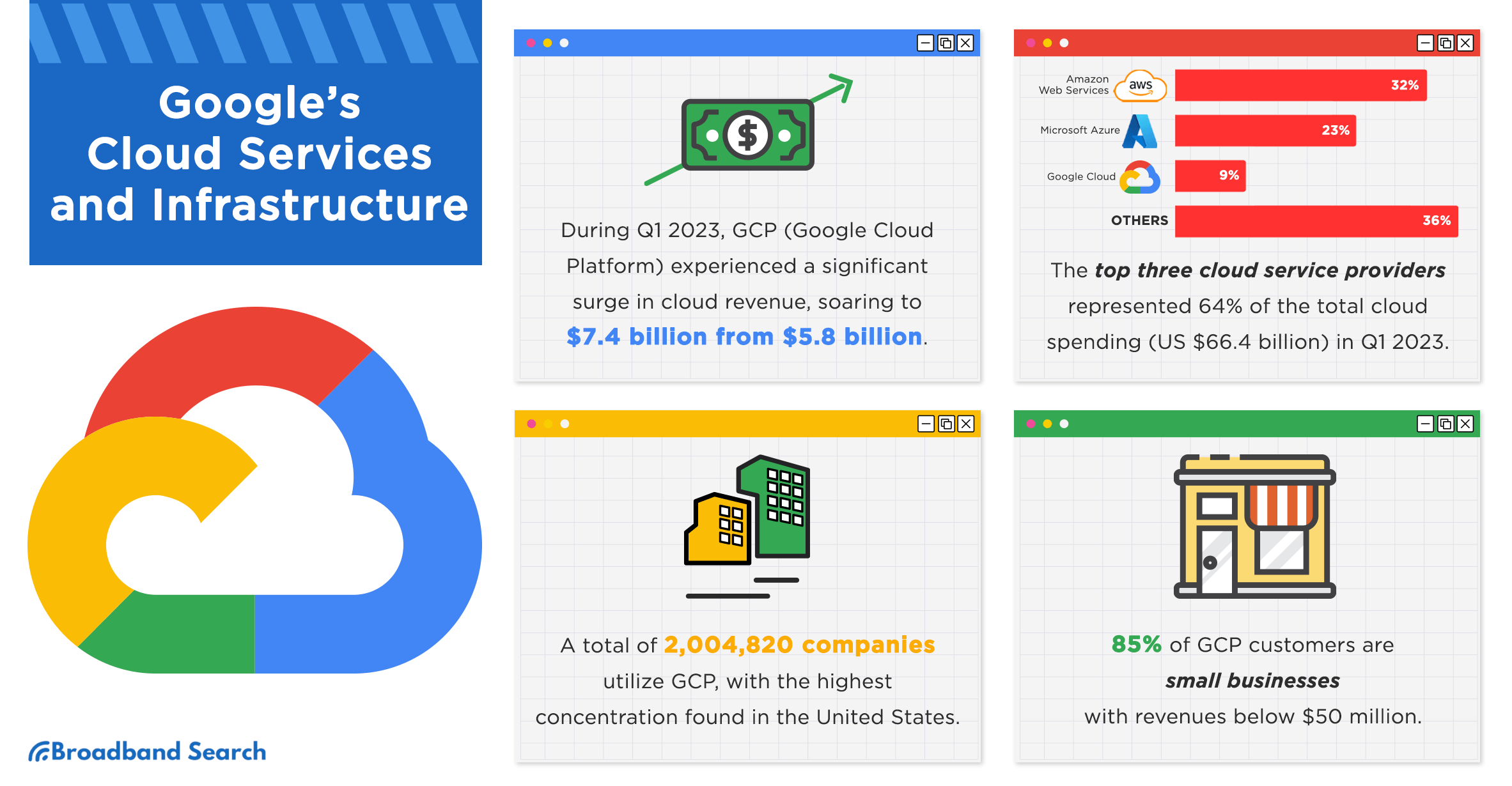
Google Cloud Platform's Revenue Growth
Google Cloud Platform (GCP) has experienced impressive revenue growth, showcasing its growing influence in the cloud market. In Q1 2023, GCP reported a substantial increase in cloud revenue, reaching $7.4 billion compared to $5.8 billion in the same period of the previous year, representing a growth rate of 27.5%. However, the most noteworthy aspect is the significant improvement in operating income. In the previous year, the company reported an operating income loss of $706 million, whereas this year it recorded a remarkable gain of $191 million.
Factors contributing to the revenue growth of GCP include:
The expansion of Google Cloud Platform (GCP) can be attributed to several key factors. First, GCP has successfully broadened its customer base, encompassing large enterprises, small and medium-sized businesses, as well as startups. This diverse range of clients showcases GCP's ability to cater to various organizational needs.
Furthermore, GCP's continuous commitment to innovation and enhancement of its cloud services has played a significant role in attracting more users and driving adoption. By staying at the forefront of technology trends and offering cutting-edge solutions, GCP has positioned itself as a preferred choice for businesses seeking reliable and advanced cloud infrastructure.
The market for cloud services is fueled by various factors, including the increasing demand for data analytics and machine learning capabilities. Companies are recognizing the importance of harnessing data-driven insights and leveraging machine learning algorithms for informed decision-making.
Additionally, the need for data center consolidation, application migration, cloud-native development, and efficient service delivery has contributed to the growth of the cloud market. Organizations are striving to optimize their operations, reduce costs, and enhance scalability by migrating their applications and infrastructure to the cloud.
Percentage of Fortune 500 Companies Using Google Cloud Services
Google Cloud services have experienced substantial traction and adoption among Fortune 500 companies, highlighting their appeal and effectiveness for enterprise customers. A study conducted in 2013 indicated that nearly 60% of Fortune 500 enterprises were utilizing at least one Google cloud service. This widespread adoption underscores the trust and confidence that major corporations place in Google Cloud for their business needs.
Furthermore, an analysis of Google Cloud Platform (GCP) reveals that it is favored by a significant number of companies. A total of 2,004,820 companies utilize GCP, with the highest concentration found in the United States. The retail industry specifically relies on GCP for its cloud infrastructure needs. Notably, the majority (85%) of GCP customers are small businesses with revenues below $50 million, while there are no large or medium-sized businesses among them.
Benefits and advantages of Google Cloud for enterprise customers include:
- Scalability: Google Cloud provides the flexibility to scale resources up or down based on business needs.
- Reliability and Performance: Robust infrastructure ensures high availability and fast response times.
- Advanced Analytics: Google Cloud offers powerful analytics tools for extracting insights from data.
- AI and Machine Learning: Google Cloud provides a range of AI and ML services to drive innovation.
5. Advertising Powerhouse
Percentage of Digital Ad Revenue Attributed to Google
In 2021, Google held a substantial position in the digital advertising landscape, accounting for approximately 28.6 percent of the total digital advertising revenue generated in the United States.
Factors contributing to Google's dominance in digital advertising:
- Vast Audience Reach: Google's extensive user base and reach across its various platforms attract advertisers.
- Advertising Tools and Formats: Google offers a wide range of advertising tools, including Google Ads, and various ad formats, allowing advertisers to reach their target audience effectively.
- Search Advertising Dominance: Google's dominance in the search engine market drives a significant portion of its digital ad revenue.
- Advanced Targeting Capabilities: Google's data and analytics capabilities enable precise targeting, enhancing the effectiveness of advertising campaigns.
Average Cost-Per-Click (CPC) for Google Ads
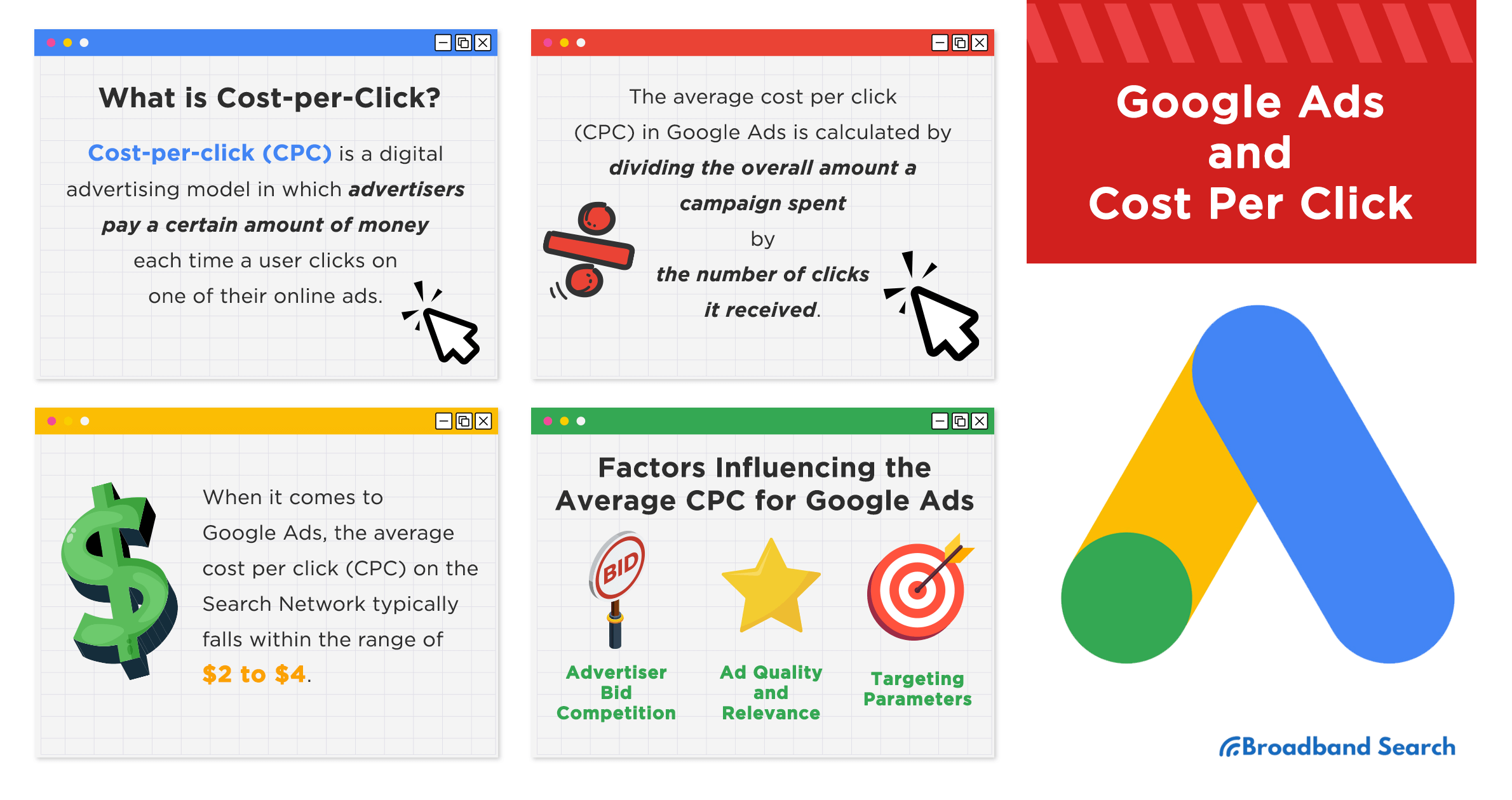 Cost-per-click is a pricing model in digital advertising where advertisers pay for each click on their ads. The average CPC for Google ads can vary based on several factors, including industry, competition, ad quality, and targeting parameters.
Cost-per-click is a pricing model in digital advertising where advertisers pay for each click on their ads. The average CPC for Google ads can vary based on several factors, including industry, competition, ad quality, and targeting parameters.
When it comes to Google Ads, the average cost per click (CPC) on the Search Network typically falls within the range of $2 to $4. This indicates the average amount advertisers pay for each click on their ads displayed in search results. Conversely, on the Display Network, the average CPC is below $1, presenting a more cost-effective option for advertisers seeking to promote their offerings through image-based advertisements.
Notably, certain keywords within Google Ads and Bing Ads command higher prices. These top-tier keywords can cost $50 or even more per click, highlighting their competitiveness and the premium advertisers are willing to pay to target specific search terms. Advertisers need to consider the value of these high-cost keywords in terms of their potential return on investment and relevance to their target audience.
Factors influencing the average CPC for Google ads
- Advertiser Bid Competition: Higher competition among advertisers for specific keywords or placements can drive up the average CPC.
- Ad Quality and Relevance: Well-crafted, relevant ads with high-quality landing pages can lead to lower CPCs due to better ad performance.
- Targeting Parameters: Advertisers can adjust targeting parameters to reach a more specific audience, potentially affecting the average CPC.
6. Mobile Influence
Android's Impact on Google's Mobile Services and Revenue Streams
Every day, a considerable number of users across the globe activate Android devices, reaffirming its widespread adoption. Android has emerged as the most popular operating system worldwide, boasting an impressive user base of over 2.5 billion active users. This extensive reach extends across more than 190 countries, solidifying Android's position as a dominant force in the mobile operating system market.
Android: Empowering Google's Mobile Services and Ecosystem
Google leverages the widespread usage of Android smartphones to integrate its core applications seamlessly. Key offerings such as Google Search, Google Maps, YouTube, and the Google Play Store are built directly into the default applications on Android devices.
When users activate an Android smartphone, they are greeted with permanent default Google-owned apps like Google Search, Google Play, YouTube, Maps, and more. These apps form the foundation of Google's mobile services ecosystem, providing users with easy access to popular Google applications and services.
Furthermore, the Android framework itself is tightly integrated with Google services. To fully utilize the capabilities of an Android device, users are required to sign in with a Google account. This integration ensures a seamless user experience, enabling access to personalized features, synchronization across devices, and access to the broader range of Google services and applications.
Android's Contribution to Google's Mobile Revenue and Services
The adoption of Android has a significant impact on Google's mobile ad revenue and the utilization of its diverse range of services on mobile devices. Google capitalizes on Android's popularity by monetizing various Android apps and services. A substantial portion of sales from the Google Play Store directly contributes to the company's earnings.
Moreover, Android serves as a catalyst for users to engage with other Google services, resulting in increased spending and time devoted to platforms like YouTube and search. This interplay between Android and Google's services creates a mutually beneficial ecosystem, where Android users actively utilize and benefit from the wide array of offerings.
The success of Android as an operating system amplifies Google's mobile ad revenue, as the extensive user base provides a substantial audience for targeted advertising. Furthermore, the seamless integration of Google services within the Android ecosystem enhances user engagement and unlocks revenue opportunities for the company.
Mobile Search Dominance
When it comes to mobile search, Google stands as the unrivaled leader. As of 2022, Google holds a staggering 93.68% market share in the mobile search engine domain. This remarkable dominance in mobile search solidifies Google's position as the go-to platform for users seeking information on their mobile devices.
Strategies employed by Google to maintain its position as the leading mobile search engine:
- Continuous Innovation: Google invests in refining its mobile search algorithms, enhancing the user experience and delivering relevant and timely search results.
- Mobile-Friendly Practices: Google emphasizes the importance of mobile-friendly websites and uses mobile-first indexing to ensure optimal search performance on mobile devices.
- Integration with Mobile Ecosystem: Google strategically integrates its services with the Android operating system, making Google Search easily accessible and seamlessly integrated into mobile devices.
7. Google Maps Reach
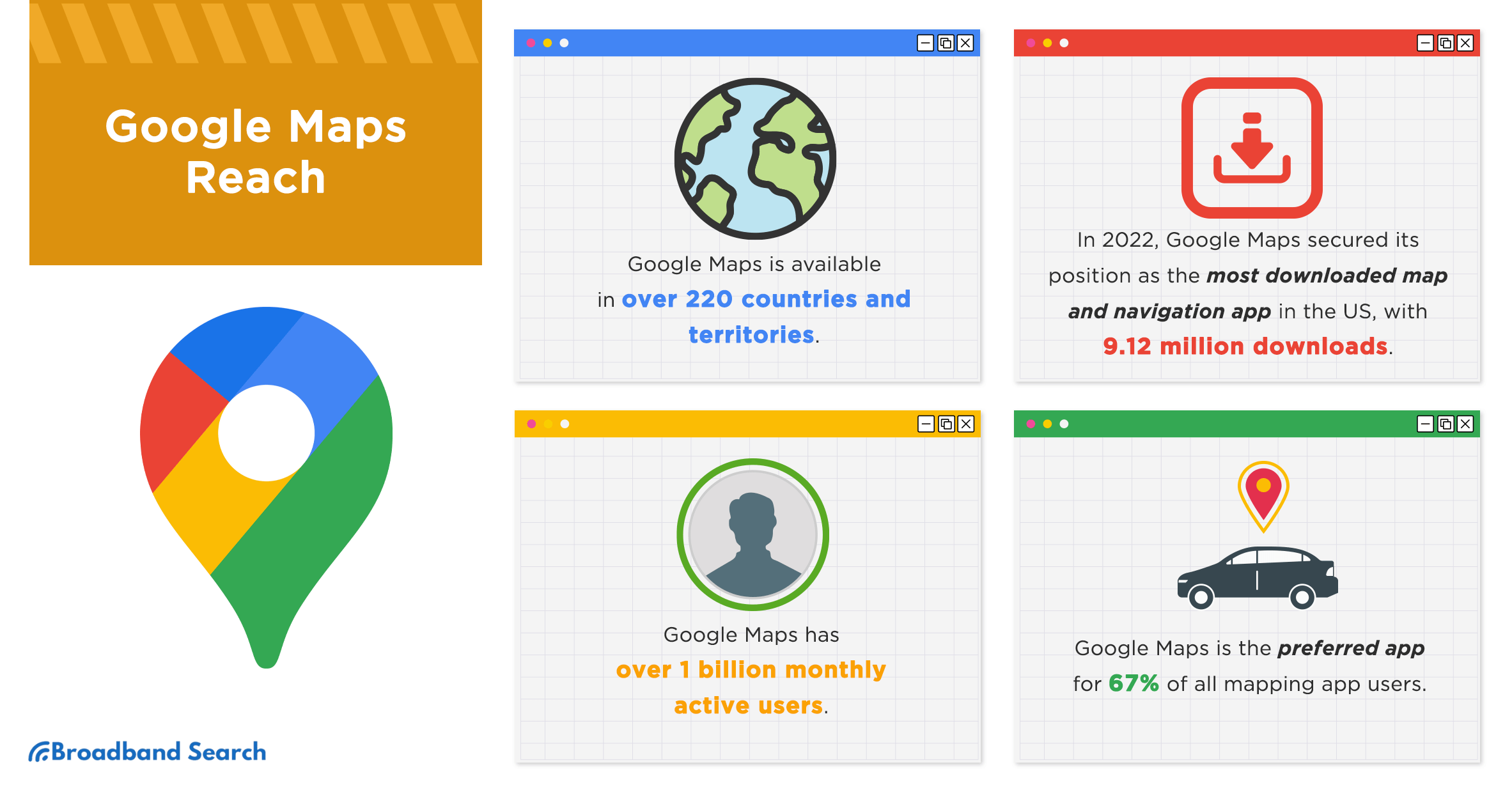
Monthly Active Users on Google Maps
Google Maps has garnered a massive user base, demonstrating its wide-ranging influence and utility. Every month, over a billion people rely on Google Maps for navigation and location-based services.
The significance of Google Maps as a popular navigation and mapping service:
- Google Maps has become an indispensable tool for individuals and businesses worldwide, providing accurate mapping, navigation, and location information.
- It offers various features, including real-time traffic updates, turn-by-turn directions, public transportation information, and local business listings.
- Google Maps' reliability, comprehensive data, and user-friendly interface contribute to its popularity and widespread adoption.
Usage Statistics for Google Maps Navigation
Google Maps Platform core products are actively integrated into more than 5 million apps and websites each week, further emphasizing its widespread adoption and integration. Additionally, Google Maps has become an integral part of smartphone usage, with 41% of smartphone owners opening the Google Maps app at least once a week.
Google Maps offers approximately $200 worth of free services each month, according to a statistical study conducted in 2022. In July 2018, Google Maps emerged as the preferred choice for 67% of navigation app users. The app consumes an average of 5MB of data per hour, ensuring efficient data management for users. Notably, in 2012, around 23 million active users of Google Maps switched to Apple Maps, showcasing a significant shift in user preference.
Approximately 5 million active websites integrate Google Maps into their platforms, leveraging its mapping functionalities. With a substantial user base of 154.4 million monthly users, Google Maps continues to be widely adopted. In 2020 alone, the Google Maps application was downloaded by approximately 23 million individuals. Moreover, in 2021, Google Maps was utilized by 54% of smartphone users, cementing its position as a popular choice. Unquestionably, Google Maps reigns as the most widely used navigation app in the United States, showcasing its dominance in the market.
Features and functionalities of Google Maps navigation
- Real-time traffic updates: Google Maps provides up-to-date information on traffic conditions, allowing users to make informed routing decisions.
- Alternative routes: Google Maps offers alternative route suggestions to help users avoid congestion or find the most efficient path.
- Integration with public transportation: Users can access public transportation schedules, routes, and real-time updates within Google Maps.
- Points of interest: Google Maps displays nearby businesses, landmarks, and attractions, assisting users in discovering their surroundings.
8. Impact on E-commerce
Influence on Product Discovery
When it comes to initiating product searches, Google plays a crucial role, serving as a vital starting point for online shoppers. A recent study revealed that a significant percentage of online shoppers, approximately 35%, turn to Google as their primary search destination when beginning their product search journey. This highlights the importance of Google in influencing the initial stages of online shopping.
Furthermore, statistics indicate that nearly 49% of surveyed shoppers rely on Google to discover or find new items or products. This showcases the significant impact Google has in helping users explore and uncover new offerings in the online marketplace.
Factors contributing to Google's role as a starting point for online shopping include:
- Search Engine Dominance: Google's vast user base and search engine dominance make it the go-to platform for users seeking product information.
- Comprehensive Search Results: Google provides a wide range of search results, including product listings, reviews, and relevant websites, facilitating product discovery.
Influence of Google Shopping on Purchase Decisions
Google Shopping, a service that allows users to compare products and prices, plays a significant role in influencing purchase decisions. Google Shopping provides a platform for retailers and brands to showcase their products, including product images, descriptions, ratings, and pricing information.
Key factors contributing to the influence of Google Shopping on purchase decisions include:
- Product Reviews and Ratings: Users rely on reviews and ratings from other customers to assess the quality and reputation of products.
- Pricing Information: Google Shopping allows users to compare prices across different retailers, helping them make informed purchasing decisions.
Optimizing search engine optimization (SEO) for improved visibility on Google:
- Businesses and retailers optimize their online presence to improve visibility on Google's search results page.
- SEO strategies focus on optimizing product descriptions, titles, and other elements to increase the likelihood of appearing in relevant search queries.
- Enhanced visibility on Google increases the chances of attracting potential customers and driving e-commerce sales.
9. Impact on Education
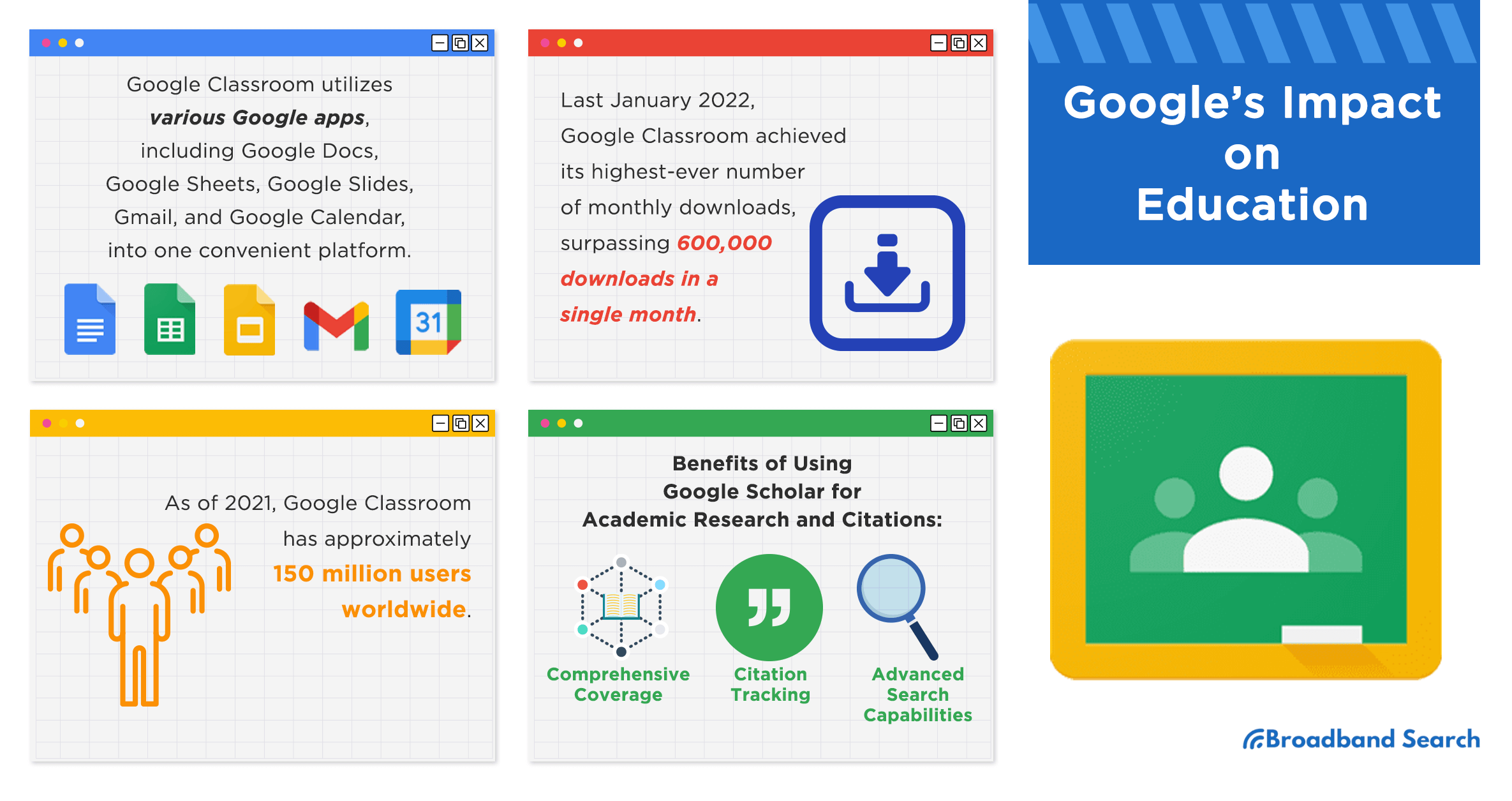
Number of Google Classroom Users
Google Classroom has emerged as a powerful platform, attracting a significant user base seeking educational solutions. In 2021, the number of users utilizing Google Classroom for educational purposes surpassed an impressive milestone of 150 million worldwide. This notable increase of almost 100% from 2019 showcases the growing popularity and widespread adoption of Google Classroom.
Notably, K–12 schools in the United States have embraced Google Classroom as a fundamental component of their teaching packages. The platform's integration within these schools demonstrates its effectiveness in facilitating remote learning and supporting educational endeavors.
Features and functionalities of Google Classroom
- Google Classroom provides a comprehensive set of tools for teachers and students to facilitate virtual learning and collaboration.
- Teachers can create and manage classes, distribute assignments, provide feedback, and engage with students in a centralized online environment.
- Students can access learning materials, submit assignments, participate in discussions, and collaborate with peers.
Impact of Google Classroom on traditional classroom settings and distance learning initiatives:
- Google Classroom has significantly impacted traditional classroom settings by integrating technology to enhance teaching and learning experiences.
- In distance learning scenarios, Google Classroom has played a pivotal role in enabling remote education, allowing for seamless communication and assignment management between teachers and students.
- The platform promotes organization, efficiency, and accessibility, fostering a more interactive and engaging learning environment.
Usage Statistics for Google Scholar
Google Scholar has established itself as a prominent academic search engine, indexing a wide range of scholarly literature such as research papers, theses, and conference papers. With its comprehensive coverage and extensive database, Google Scholar serves as an indispensable tool for millions of users engaged in academic research and scholarly pursuits.
A 2019 study highlighted the impressive scale of Google Scholar, which indexed a staggering 389 million records, offering the largest volume of scholarly information among all available resources. This demonstrates the vastness and richness of its collection, making it a valuable resource for researchers across various disciplines.
In addition, an estimation made in 2014 suggested that Google Scholar encompassed approximately 100 million documents, covering an impressive 88% of all scholarly documents accessible on the English web. This indicates the broad scope and inclusiveness of Google Scholar's indexing capabilities, making it a comprehensive platform for accessing scholarly content.
By providing researchers with a vast repository of academic resources, Google Scholar continues to facilitate the discovery and dissemination of scholarly knowledge, empowering users in their pursuit of academic excellence and innovation.
Benefits of using Google Scholar for academic research and citations:
- Comprehensive Coverage: Google Scholar provides access to a wide range of academic sources, allowing researchers to explore diverse literature in their field.
- Citation Tracking: Researchers can track citations of their own work or monitor the impact of other publications by viewing the number of citations received.
- Advanced Search Capabilities: Google Scholar offers advanced search features, enabling users to refine their queries and locate specific research papers or authors.
10. Artificial Intelligence Advancements
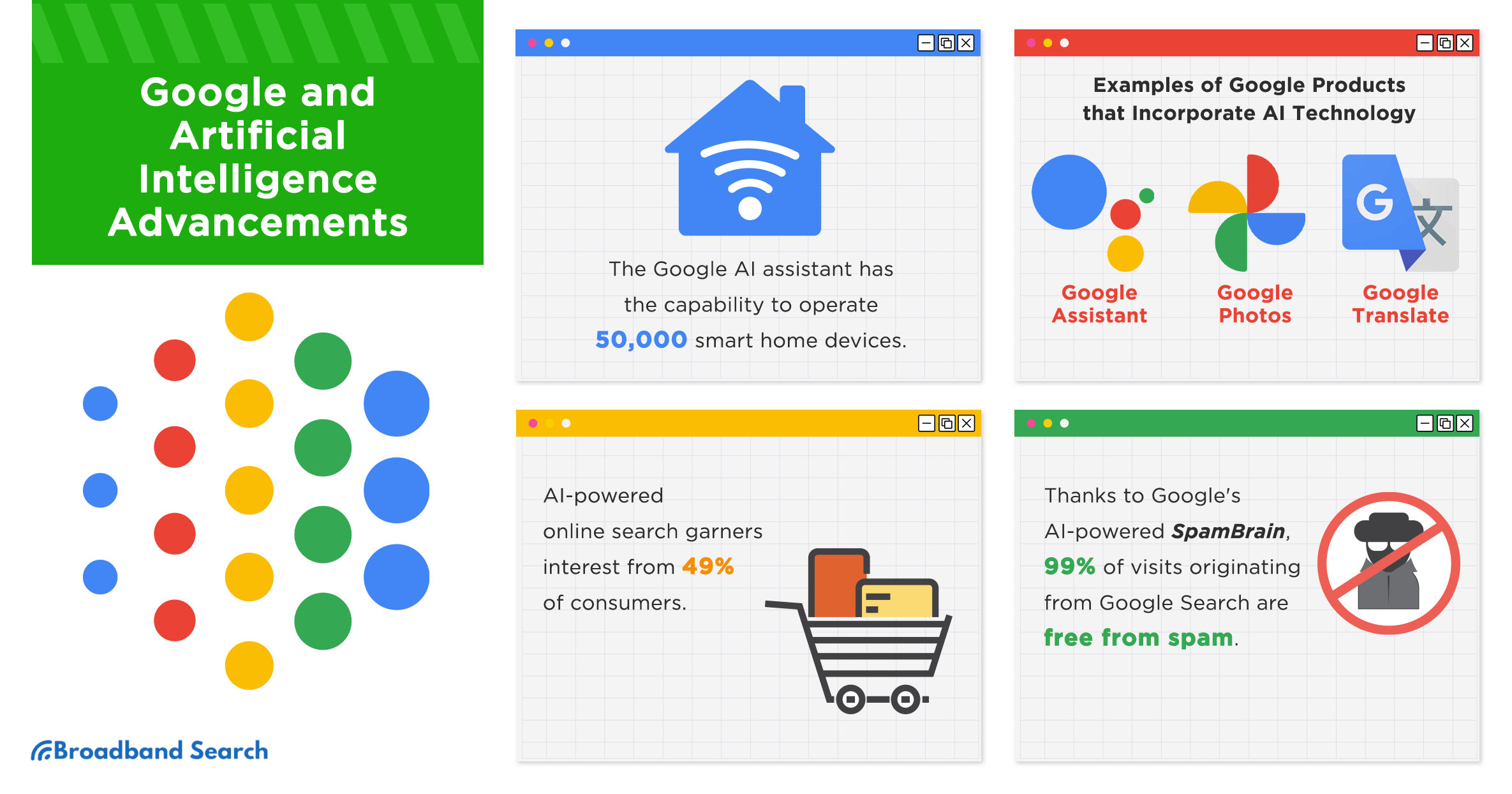
Applications of AI in Google Products
Google continues to leverage the power of AI technology across its product portfolio, revolutionizing the user experience and expanding the functionality of its offerings. With a seamless integration, Google has incorporated its latest AI advancements into a diverse range of 25 products. Notable examples include search updates, which now provide more intelligent and personalized results, and a remarkable feature in Gmail that assists users in composing emails.
Examples of Google Products That Incorporate AI Technology
Google Assistant: An intelligent virtual assistant that utilizes natural language processing and machine learning to provide voice-activated assistance.
Google Photos: Utilizes AI algorithms for automated organization, tagging, and smart image recognition to enhance photo management.
Google Translate: Employs AI-powered machine translation to enable real-time language translation across different languages.
Use Cases and Benefits of AI Integration in Google Products
- Enhanced User Experience: AI enables Google products to understand user preferences, personalized recommendations, and deliver more relevant and accurate results.
- Automation and Efficiency: AI streamlines processes, automates repetitive tasks, and improves overall efficiency in various Google products.
- Advanced Image and Speech Recognition: AI algorithms enable Google products to analyze and interpret visual and auditory data, leading to improved image recognition, speech-to-text conversion, and voice recognition capabilities.
Ethical Considerations and Challenges Associated with AI Implementation in Google Products
- Privacy and Data Protection: The use of AI necessitates careful handling of user data and ensuring privacy protection to maintain user trust.
- Bias and Fairness: Addressing biases in AI algorithms and ensuring fairness in the outcomes they produce are essential considerations to prevent discriminatory practices.
- Transparency and Explainability: The challenge lies in making AI algorithms transparent, providing explanations for decisions made by AI systems to build user trust and understanding.
11. Google's Environmental Initiatives: Promoting Sustainability
Google's Circular Economy Approach
Google has embraced a circular economy approach as part of its commitment to environmental sustainability. The company focuses on reducing waste, maximizing resource efficiency, and promoting recycling and reuse practices throughout its operations. By adopting circular economy principles, Google aims to minimize its environmental impact and contribute to a more sustainable future. As of the latest data, Google has reached and surpassed its initial target of matching 100% of its global energy consumption with renewable energy purchases.
Water Conservation Efforts
Google recognizes the importance of water conservation and actively implements measures to reduce water consumption. The company employs innovative technologies and best practices to optimize water usage in its data centers, offices, and operations. By prioritizing water efficiency, Google contributes to the preservation of this vital natural resource and fosters responsible water stewardship.
Sustainable Supply Chain Initiatives
Google is dedicated to promoting sustainability across its supply chain. The company collaborates with suppliers to encourage environmentally friendly practices, such as reducing emissions, conserving resources, and ensuring responsible sourcing. By working closely with its partners, Google aims to create a more sustainable supply chain that aligns with its commitment to environmental stewardship.
Through its circular economy approach, water conservation efforts, and sustainable supply chain initiatives, Google demonstrates its unwavering dedication to environmental sustainability. By integrating these practices into its operations, Google sets a strong example for other companies to follow, fostering a collective effort to create a greener and more sustainable future.
The BottomLine
Through its dominance in search engine market share and the staggering number of daily searches conducted on its platform, Google continues to be the go-to source for information and exploration. With its extensive user base and reach, Google has become an advertising powerhouse, capturing a significant percentage of digital ad revenue and setting the industry standard for cost-per-click rates. With a massive user base for products like Gmail, Google Maps, and Google Chrome, it has solidified its position as a tech giant. Google's innovations in artificial intelligence have transformed its offerings, enhancing user experiences and providing advanced capabilities.
The statistics speak for themselves: billions of active users worldwide, a significant percentage of online shoppers starting their product search on Google, and a vast monthly active user base for Google Maps. Furthermore, Google's commitment to sustainability and renewable energy is evident in its environmental initiatives and data center practices. As Google continues to evolve and innovate, it remains a driving force in the digital landscape. With its diverse product portfolio, global reach, and commitment to technological advancements, Google is poised to shape the future of the digital world.
FAQ
How has Google solidified its position as a tech giant beyond search and advertising?
Google has amassed a massive user base for its products like Gmail, Google Maps, and Google Chrome. These products have become integral to users' daily lives, contributing to Google's tech giant status.
What role does artificial intelligence (AI) play in Google's offerings?
Google has leveraged AI in products like Google Assistant and Google Photos, enhancing user experiences and providing advanced capabilities such as voice-activated assistance and smart image recognition.
Can you provide some numbers to highlight Google's influence?
Google boasts billions of active users worldwide, indicating its significant reach and impact. Moreover, a substantial percentage of online shoppers begin their product search on Google, and Google Maps enjoys a vast monthly active user base.
What sets Google apart in terms of sustainability and environmental initiatives?
Google has made commendable commitments to sustainability and renewable energy. Through its environmental initiatives and data center practices, Google strives to reduce its carbon footprint and contribute to a more sustainable future.
How does Google continue to innovate in the digital landscape?
Google's commitment to technological advancements and its diverse product portfolio enable it to stay at the forefront of innovation. The integration of AI, ongoing improvements in user experiences, and the introduction of new features and services demonstrate Google's dedication to innovation.

